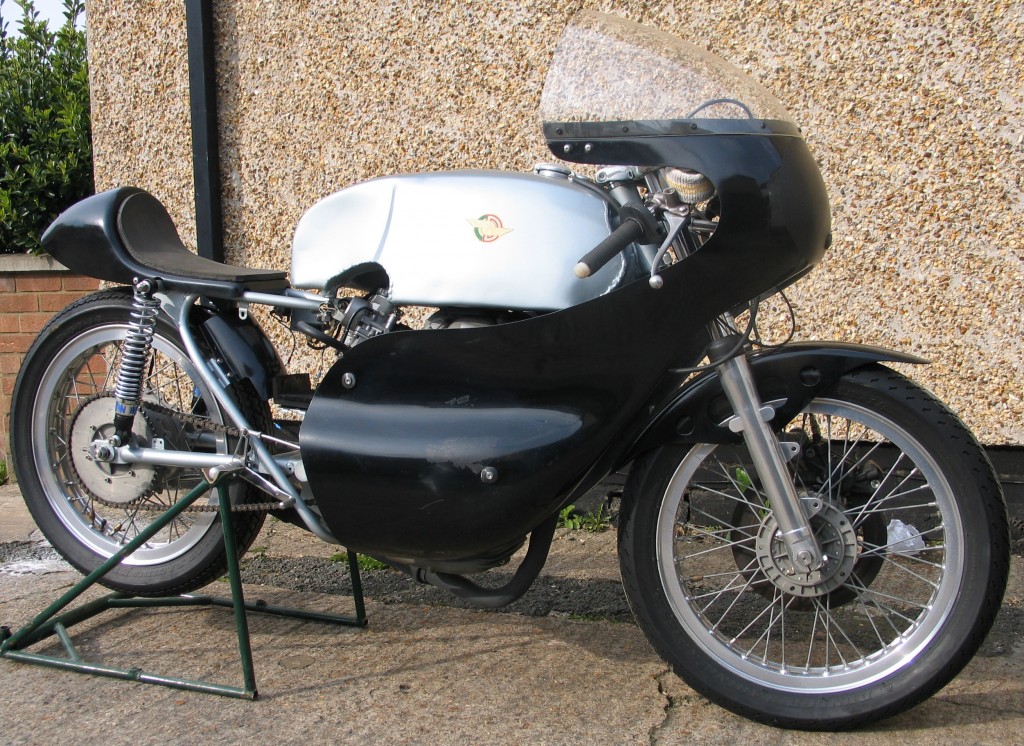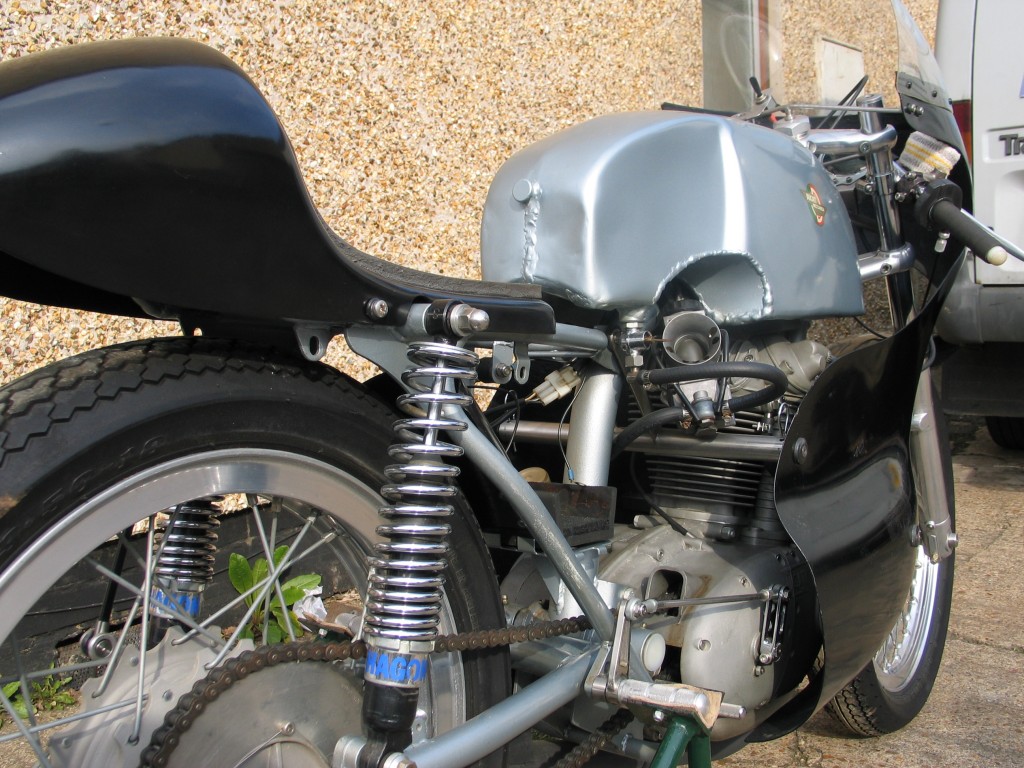Performance tuning a Ducati Mach 1
The first thing to do is lighten everything throughout the engine, but not compromise on the strength and reliability of the working parts. The project was carried out by me to contest a Ducati Mach 1 in a two stroke class racing against Yamaha TDIC’s and Suzuki T20’s, and to attempt to beat some of the modern single cylinders in the National single cylinder championships. The only way to contest an old Ducati is to make it rev like it’s never revved before i.e. 13,500 RPM.
To make the machine competitive in all of the classic lightweight classes is to shorten the stroke by 4mm. I shortened mine by the same and used the 350cc barrel and piston which brings the overall cc to 236.
The standard Conrod was used as the steel ones are stronger and more reliable. The valves were enlarged considerably but the standard valve seats were retained but re-cut to suit the new valves; the valves were also machined to give good gas flow. To make the valves snap open and closed quick enough, stronger hair springs were fitted. The wire gauge of the springs is 156 thou thick. These were operated by red and white cam. If one uses too light a spring one would experience valve bounce.
The compression ratio measured with a burette was 14.5 to 1. Although I could measure 21 to 1 without a head gasket but this would compromise reliability and I would have to cheat using octane booster and any over revving would be detrimental to performance and reliability. The valve to piston clearance was measured as 050 thou using Plastigauge. I failed to mention the 350cc piston was highly modified by welding and re-cutting the valve seat pockets. The piston had to be modified due to lack of compression and the crown shape was wrong.
What I wanted the piston to do was to squish as much fuel without detonation but to burn everything down to the top compression ring. This is important as a lot of fuel sits just above the top compression ring being un-burnt and passing out through the exhaust port. Detonation is in many tuners minds, a bad thing to happen in an engine but this is not so as long as it is controlled. Head profile and piston crown clearances sort this problem out.
To attain top revs it is paramount to lighten all rotational weight. The thing to do is remove the Magdyno from the end of the crank and make an outrigger bearing in the primary chain case to support the crank, saving it from whipping at high revs. The next step is to look at lightening the gearbox; this is easy as all of the gears are thicker and heavier than they need to be. All of the gearbox gears can be lightened in two ways, drilling and machining on a lathe the skin hardness can be broken using a correctly sharpened masonry drill once through the surface hardness of a gear, the inner metal is like butter.
After weighing the gear train and subtracting what you have machined and drilled out you should have saved about 1.5 pounds in weight. Another critical part of the fuel burning process is the exhaust system design. The ideal length through calculations is about 9 1/2 foot for the header pipe and the silencer on the end amounts to approximately 13 foot long.
Having access to a Dynonometer to test the machine on, I found I could use the standard header pipe and develop a silencer to come within length and decibel tolerances to give maximum performance. A machine goes no where without correct carburation thus the standard Ducati carb could not live up to the demands of the drastically modified engine. Something more suitable was an Amal concentric as this carb has more scope for fine tuning and ease of obtaining accessories and upgrades. After all of the modifications it is a good idea to set the carb on the rich side so as to control detonation.
 The ignition system is controlled using Rita ignition and a dyna coil with twin plug leads. The reason for the twin lead is that I have fitted a 10mm spark plug near the top bevel thus producing a twin plug head. Another important point to take into consideration is to modify the inlet tract so as to make it as straight as possible, you will find that when this is done that there will be a break out in the cylinder head. All you have to do is either weld the hole up or use Devcon aluminium filler, after filling, blend the inlet tract in. another important job is the front brake, I employed a Suzuki GT380 disc and callipers to produce a unit that I could use for very late breaking into corners.
The ignition system is controlled using Rita ignition and a dyna coil with twin plug leads. The reason for the twin lead is that I have fitted a 10mm spark plug near the top bevel thus producing a twin plug head. Another important point to take into consideration is to modify the inlet tract so as to make it as straight as possible, you will find that when this is done that there will be a break out in the cylinder head. All you have to do is either weld the hole up or use Devcon aluminium filler, after filling, blend the inlet tract in. another important job is the front brake, I employed a Suzuki GT380 disc and callipers to produce a unit that I could use for very late breaking into corners.
A fairing was fitted to save about 2 horse power of wind drag and a low seat with minimal padding was used so as I could paddle start the bike. I have not gone into too much depth regarding all of the tuning modifications as I don’t want to bore you, the reader. But if you have any questions I will be happy to divulge the finer points.
The Ducati, when finished, should start with ease after a couple of paddles, you don’t have to stand by the side of your machine and bump start it. Prior to a serious race you will have to heat the engine oil up in a saucepan over a gas burner and pour it into the engine. The bike will also need a new plug fitted after it has been heated over the burner. The engine has now been primed ready for the start line without having to warm it up.
As with all Ducati’s, road holding is steady with warnings from the frame when it is being pushed too hard. In classic racing I use Dunlop KR 124 tyres and in modern racing I use Dunlop KR108 cut slicks. Both tyres work admirably in wet weather but the KR108’s have the edge due to there softer compound. All in all, the Ducati ultra, ultra short stroke is still a championship winner!

Pingback: acne cyst
Would a lean carburetor mixture make my Ducati Sebring’s exhaust glow red?
Tim
Yeah, lean mixture or ignition too far advanced.